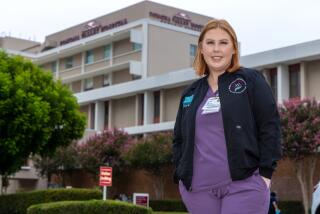More U.S. moms embrace breastfeeding, led by Idaho and California

- Share via
Breastfeeding is on the rise in the U.S., with 77% of new mothers nursing their newborns and nearly half sticking with it for at least six months, according to new data from the U.S. Centers for Disease Control and Prevention.
The CDC’s 2013 Breastfeeding Report Card finds that the proportion of mothers who nurse their babies at all increased significantly between 2000 and 2010 – and that the duration of nursing increased steadily as well.
The American Academy of Pediatrics recommends that babies consume nothing but breast milk for about six months, and that after they start eating solid foods they continue to nurse until their first birthday. Mothers seem to be following this advice: In 2010, 49% of mothers were breastfeeding at the six-month mark and 27% were still doing so after one year. In 2000, only 35% of moms nursed for six months and 16% nursed for a year.
The state most receptive to breastfeeding is Idaho, where 91.8% of new mothers nursed their babies for some period. That was followed by California at 91.6%, Oregon at 90.2%, Colorado at 89.1% and New Hampshire at 88.%. By six months, the top breastfeeding states were Idaho (74.5%), California (71.3%), Oregon (71%), Hawaii (64.9%) and Utah (64.2%).
By the one-year mark, Idaho had ceded the top spot to Utah, where 52.3% of mothers nursed for that long. Idaho was second with 45.5%, followed by California (45.3%), Hawaii (42.2%) and Vermont (40.7%).
Breast-feeding could mean 4 IQ points at age 7
At the other end of the spectrum was Mississippi, where only 50.5% of new mothers nursed their babies for any length of time, 19.7% nursed for six months and 9.1% nursed for a full year. Other states with consistently low figures include Alabama, Arkansas, Kentucky and Louisiana, according to the report card.
The breastfeeding data in the report were from the CDC’s National Immunization Survey.
The CDC said more hospitals were facilitating breastfeeding by helping mothers bond with their babies during the crucial early hours of life.
In 2011, 54% of hospitals allowed most newborns to have skin-to-skin contact with their mothers after birth, up from 41% in 2007, according to the report. In addition, 37% of hospitals allowed newborns to “room in” with their moms in 2011, up from 30% in 2007. Those figures were drawn from the CDC’s Maternity Practices in Infant Nutrition and Care Survey.
Dr. Tom Frieden, director of the CDC, said nursing mothers helped their babies avoid short-term health problems like ear infections and gastrointestinal infections as well as chronic conditions like diabetes and obesity. They’re also giving their children extra IQ points, according to a study out this week that linked breastfeeding with cognitive performance in children at ages 3 and 7.
For moms, nursing reduces the risk of breast and ovarian cancer, Frieden said in a statement.
The nation as a whole has a lot to gain by encouraging more mothers to breastfeed. A study published in Pediatrics in 2010 found that “if 90% of U.S. families could comply with the medical recommendations to breastfeed exclusively for six months, the United States could save $13 billion a year and prevent an excess 911 deaths annually.”
Thursday is the start of World Breastfeeding Week and, in the U.S., National Breastfeeding Month. The CDC’s breastfeeding website has all sorts of information on breastfeeding, including advice on where to get support.
Return to Science Now.







